This is the second part in our series on how to write a Japanese resume (rirekisho).
If you haven’t already seen part one, which explains how to fill in the first section of the rirekisho – the Personal Information section, you should read that first.
Following on from the Personal Information section of the rirekisho, comes the the Education and Work History section, known in Japanese as the 学歴・職歴 (Gakureki / Shokureki).
When it comes to filling this part out, the most important thing to be aware of are certain formatting rules that are unique to the Japanese resume.
Difficulty Rating ★★★☆☆
Contents
What exactly is the Gakureki / Shokureki section for?
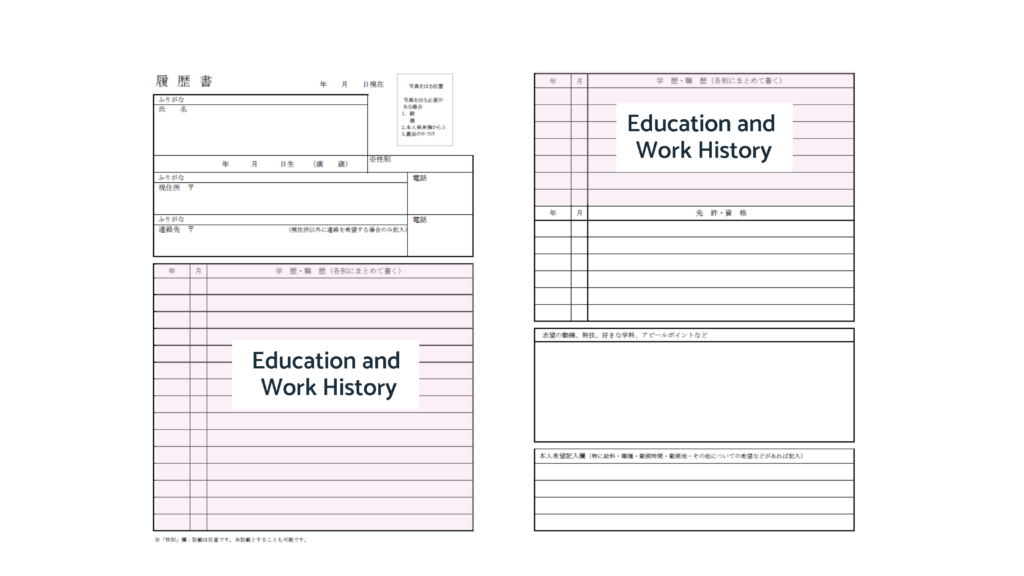
“Gakureki” means educational history, and “Shokureki” means work history.
This Gakureki/Shokurei section runs from a third of the way down the first page of the rirekisho, and on to the second page, making it the longest section.
It is where you should list all educational institutes you have attended and all jobs you have worked at, including any current roles.
In brief, you are giving employees a snapshot of:
– Where you studied / worked
– Title of course / your role
– How long you did these things
– How and why the experience ended
What the Gakureki / Shokureki isn't for
It is not a place to talk in detail about experiences and skills acquired at a job.
There will be a place for that on the Shokumukeirekisho, the second type of resume Japanese companies expect you to submit. This is simply for giving a snapshot.
Basic formatting rules
・Education is listed first, followed by work history under the subheadings
学歴 (gakureki) and 職歴 (shokureki)
・For each institution / place of work, two lines are required (one for start information, and one for end information)
・Information should be written in chronological order (starting from the earliest going to the latest)
・Dates may be written in either Japanese or Western formatting, sticking to the same format you chose for the rest of the resume. (See here for a list of Japanese and Western date equivalents)
Filling in Gakureki (Education History)
Gakureki comes first, so start by adding the title – 学歴 in the center of the longest cell.
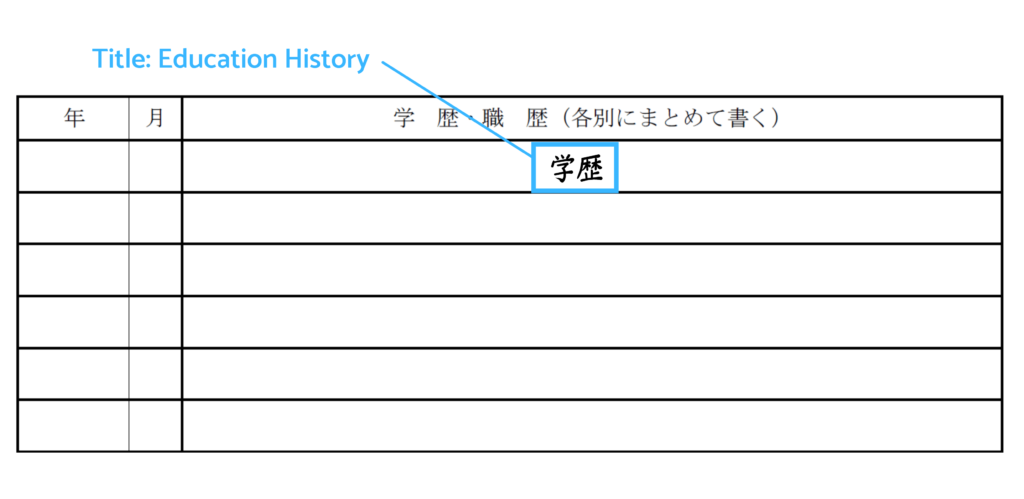
Line 1: 入学 (For details on when you entered the institution)
In the first two columns, put the year and then month respectively for when you entered the institution.
For example, if you started university on September 1st 2009, you would write “2009” (or 平成21 if using Japanese formatting) in column 1, and “9” in column 2.
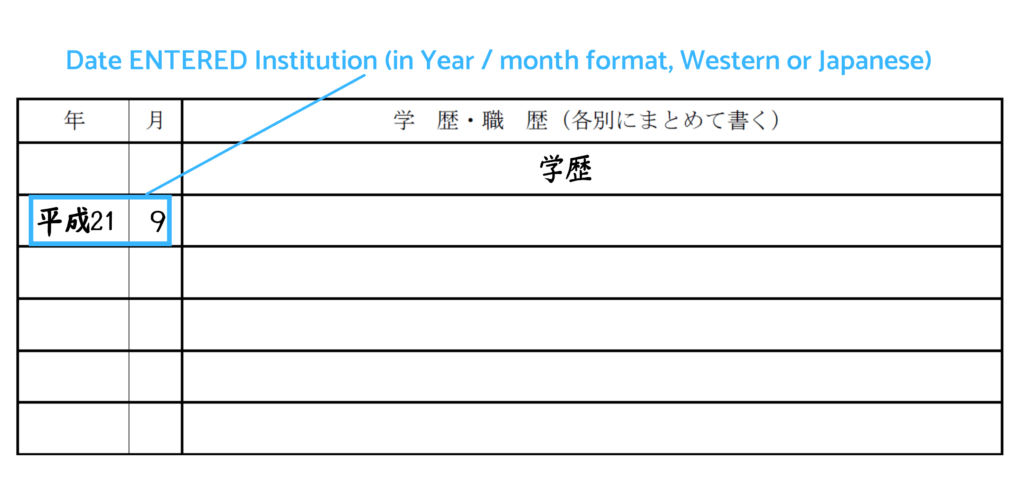
In the widest column, you will need to put three pieces of information.
1. The name of the institution attended (〇〇大学)
2. Your major and the name of the course if applicable (〇〇学部 or 〇〇専攻)
3. The word 入学 ( entered)
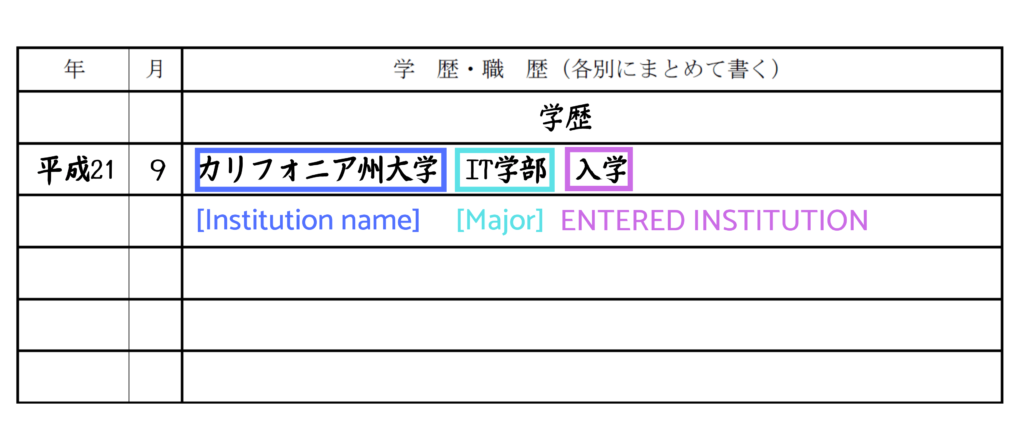
Tips
・ Be sure to separate the information with spaces.
・ Names of schools and courses should be written in full, without abbreviations.
・ If some element of your study relates to the job you are applying to, this is a good opportunity to mention it too.
Line 2: (for details on when you graduated / left the institution)
The second line follows exactly the same format as the first, only this time you will enter the date you graduated, followed by the word “graduated”, which depending on the type of degree you did, is expressed with a different kanji.
Use 卒業 for a Bachelor’s degree
For example, if you graduated from the University of California’s IT department with a Bachelor’s degree:
カリフォニア州大学 IT学部 卒業
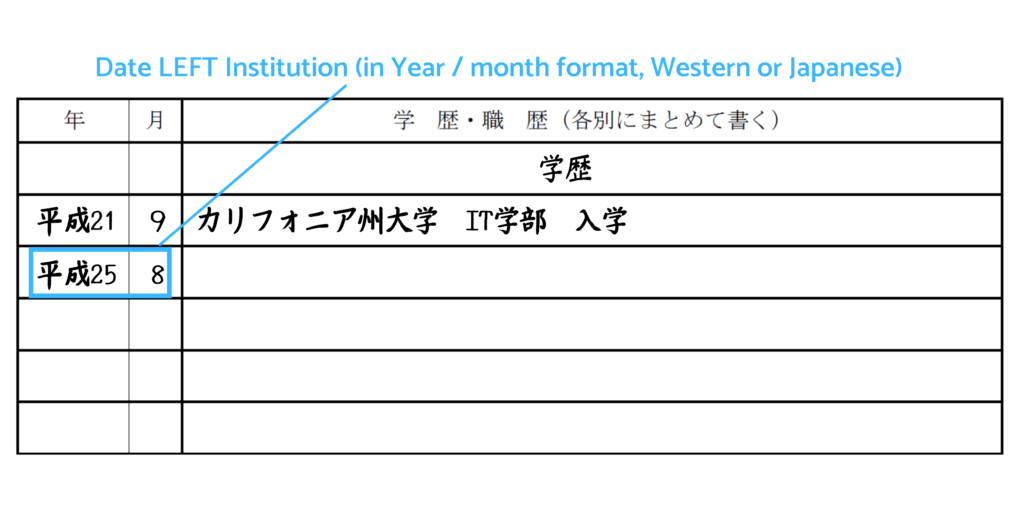
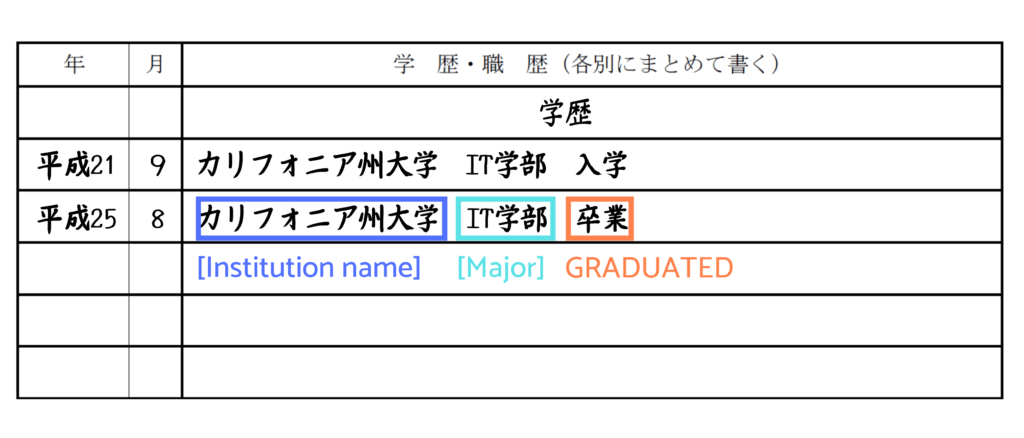
For indicating graduation and completion for other kinds of degrees
修士課程 修了 for a Masters course
博士課程 修了 for a Doctoral course
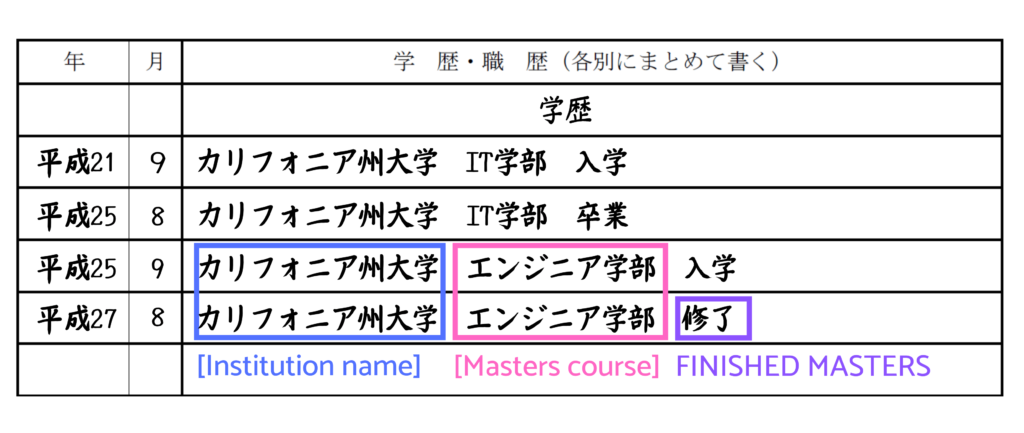
For other circumstances (absence of graduation)
If you are still studying
You can use 卒業見込み
Left without completing course
If you left without finishing your course, you can write 中途退学.
If there is a reason that you want to share for this, such as illness, lack of study funds etc., it is acceptable to write your reason briefly on the next line.
Eg ~により中途退
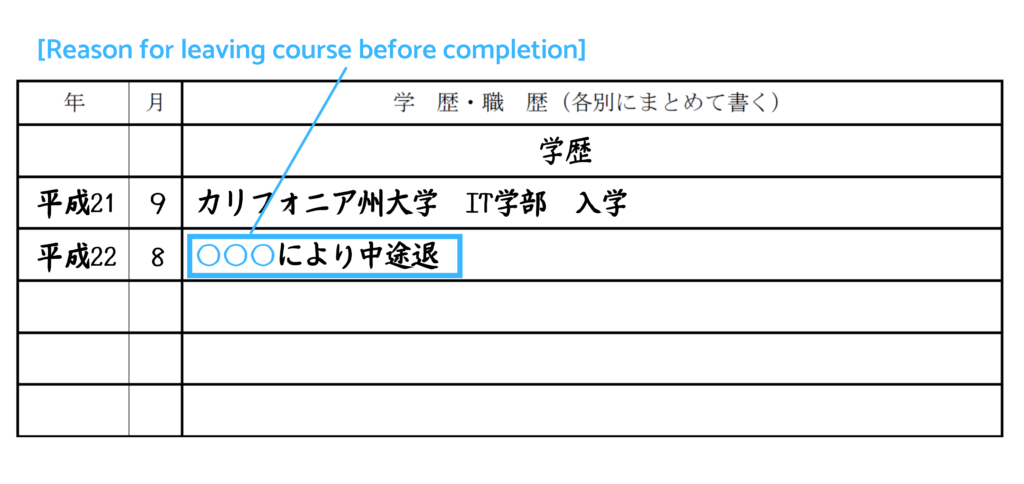
Filling in Shokureki (Work History)
Take a space between the last line of the Gakureki section, and start by writing 職歴 in the center of the longest cell.
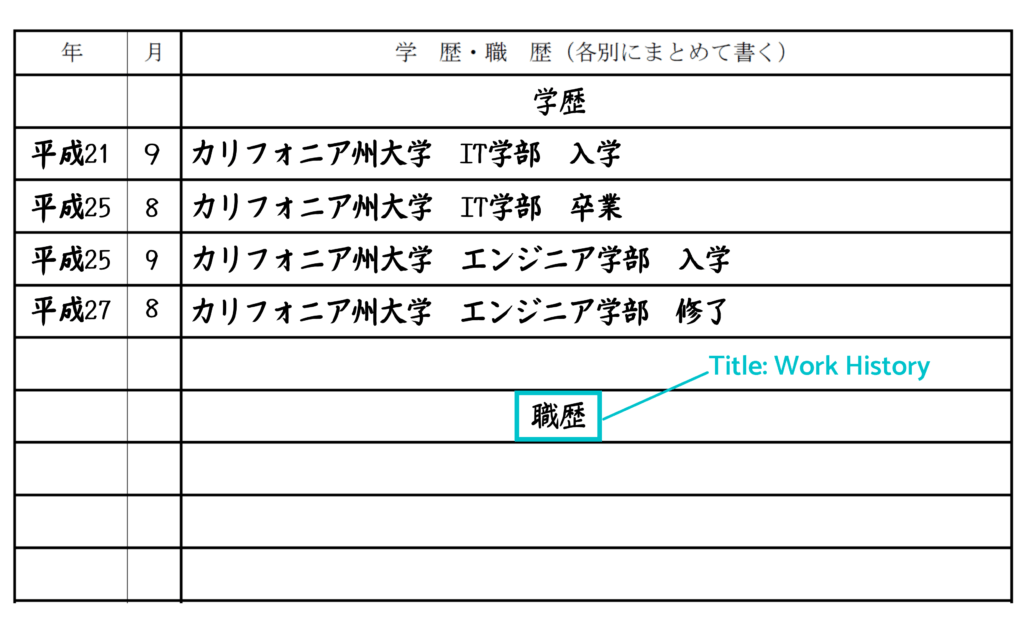
Every place of employment is made up of two one three lines:
Line 1; Details of how and when you started a job.
Line 2: (optional) Details of what your role was at the job
Line 3: Details of how and when you left
Repeat the following process for every job worked at in chronological order, until you reach your present job.
If you changed roles at your job, one job entry could consist of four or five lines.
However, we recommend keeping the rirekisho brief, and going in to detail on your shokumukeirekisho instead.
Line 1: 入職/入社 (For details on when you entered a company)
・In the first two columns, put the year and then month respectively, as to when you entered the company.
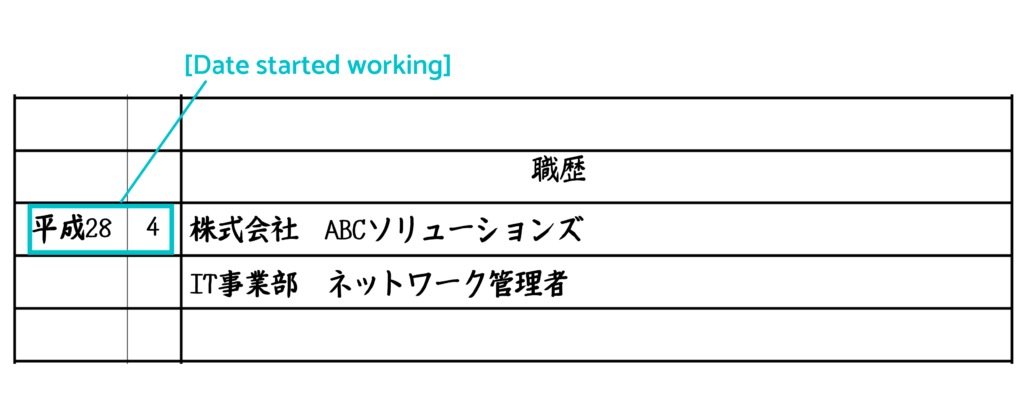
・In the widest column, fill in the official name of the company, including its registered status (as a corporation, limited company or Japanese kabushikigaisha for example).
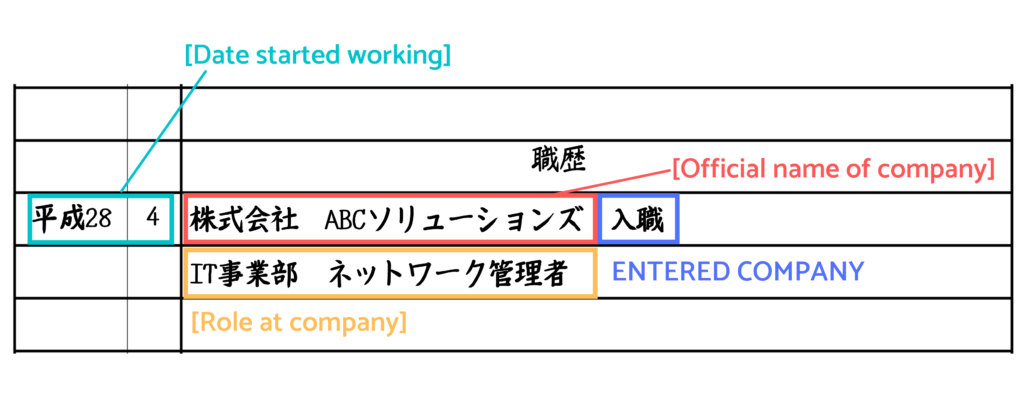
Companies that are not Kabushikigaisha
・For NPOs: 特定非営利活動法人
・For Limited companies 有限会社
・For non-Japanese companies, you can use the official English terms such as Co., Corp., Ltd. etc.
Line 2: (For details on when you left the company): Two Ways
There are a couple of ways you can format it to express leaving a company.
Method 1: Expressing how you left in simple terms
・After writing a line on when you entered a company, start a new line, and input the year and then month respectively, as to when you left the company.
・In the widest column, write the name of the company in full, and any other details, exactly as you did for the first line.
・At the end of the line, write the kanji 退職 to show that you left the company.
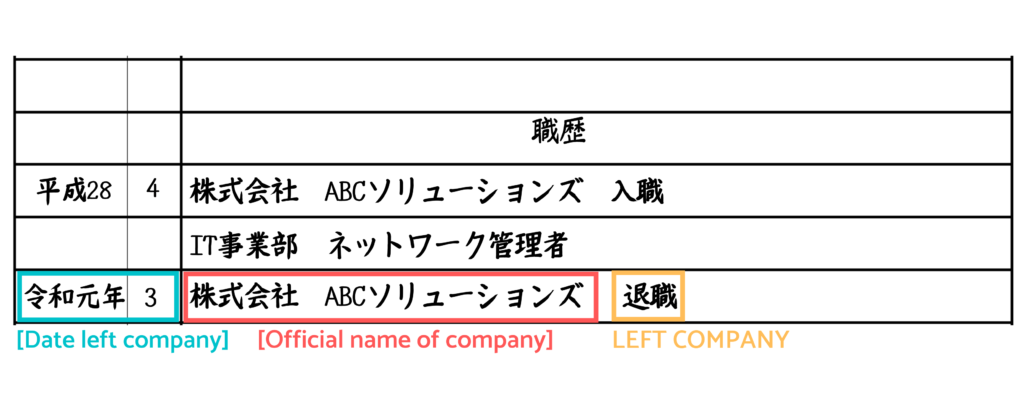
Method 2: Expressing how you left with reasons
Start a new line, and input the year and then month respectively, as to when you left the company.
Then, simply write the reason you left, using a pattern such as ~による退職 or ~のため
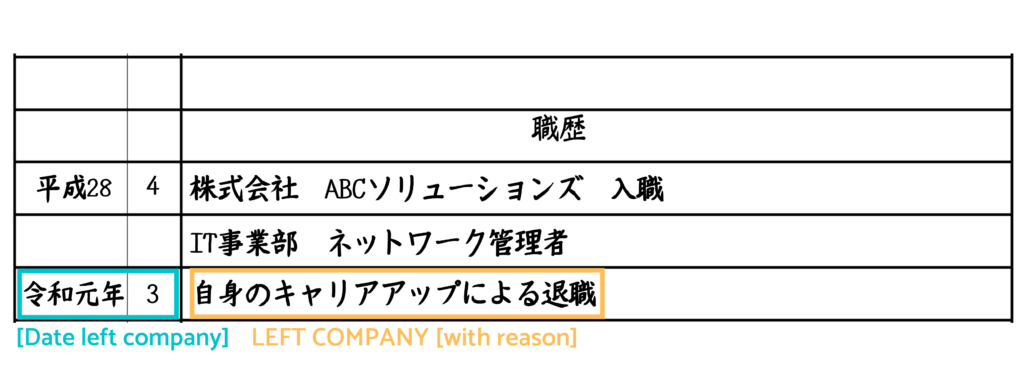
To Give a Reason or Not to Give a Reason for Leaving?
Culturally, Japan is a country that rewards and thinks highly of company loyalty. Therefore, Japanese companies can have a tendency to think cautiously on resumes where there are many job changes, or short employment periods. They might consider that the applicant is not able to stick to their work, or doesn’t care about the company.
These days this view is a little outdated, with more Japanese young people rejecting the “employer for life” model in favor of changing jobs when they feel dissatisfied, or want to excel in their career.
You might want to think about giving reasons on the rirekisho itself if you have a lot of job changes, but these can be justified with good reasons.
Just be aware that if you do not state the reason for leaving a job on your rirekisho, you might be asked about the reason at interview.
Examples of reasons you might give for leaving a company:
Marriage
Childbirth
To look after parents
To forward one’s career
Company bankruptcy
Laid off
End of contract
結婚
出産
両親の介護
自身のキャリアアップ
会社の倒産
会社都合での解雇
契約が満了しての退職
Formatting the last entry (i.e. your current employment)
At the end of the shokumureki comes your current role if applicable.
After writing a line for when you entered the company, take a new line and write the words 現在に至る to show that you are still working at this company.
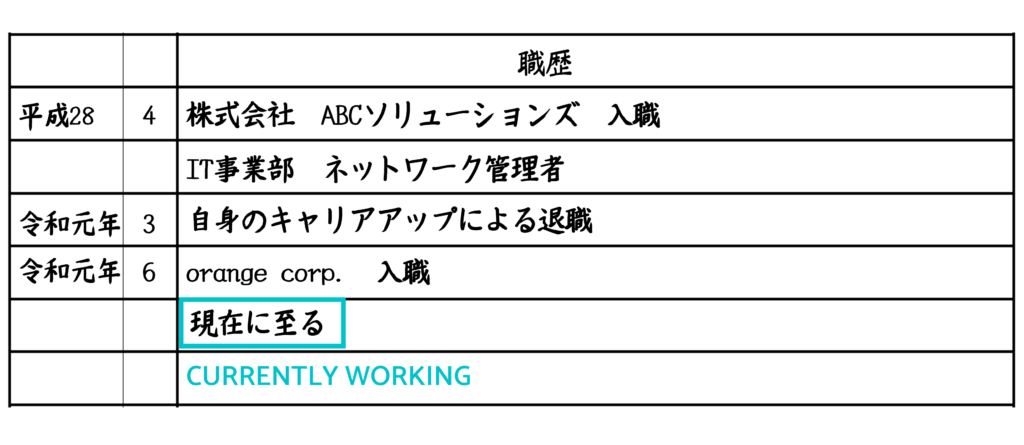
Or, if you have already decided on the date you will leave the company, you can write
退職予定
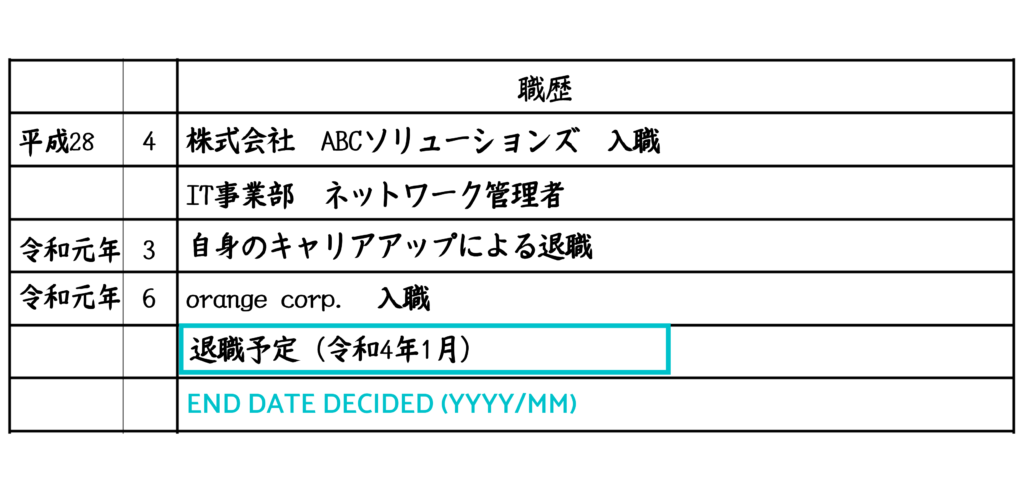
Ending (以上)
Finally, on a new line, write the word 以上 to show that you have finished.

If you have never worked
If you are still of school age or just about to graduate, you should still create a title for the work history part, and fill it in simply with the word なし, as in the example below.
Remember that all sections of a rirekisho need to be filled out with some text, even if there is nothing to apply.
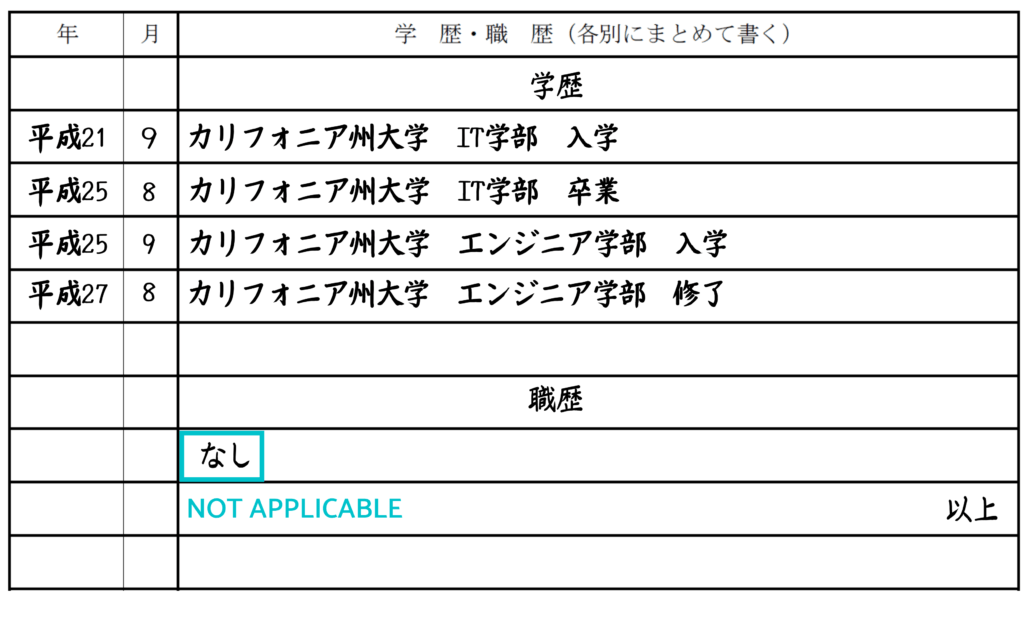
入職・ 退職 / vs 入社・退社
You will see people using both of these patterns to express joining and leaving a company.
Both are correct, but it is worth thinking about the nuance of the kanji when you choose which set to use.
In the 入職・ 退職 pattern, we have the character 職 (shoku), which refers to work, and so the words mean “started work” and “finished work” respectively.
In the 入社・退社 pattern we have the character 社 which means “company”, so the words mean “joined company” and “left company”.
Using 入職・ 退職 is more neutral, as it can be used to refer to organizations that are not really companies, such as government bodies, schools or hospitals.
When the company has changed names
If your company now goes by a different name, you can express this by adding the new name in brackets, to say “now ~”.(現 (company name) 株式会社).
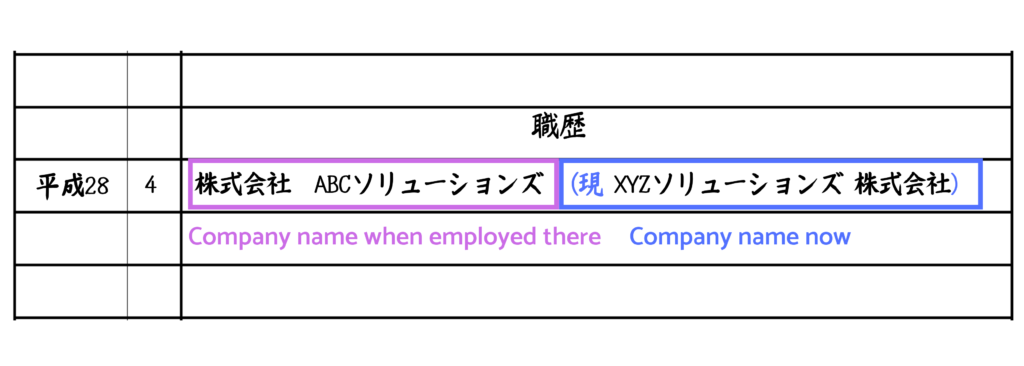
If you did work on behalf of a temp agency
If you did work on behalf of a temp agency, you can express this as:
(Temp agency name) より(job)(dispatched office name)に派遣
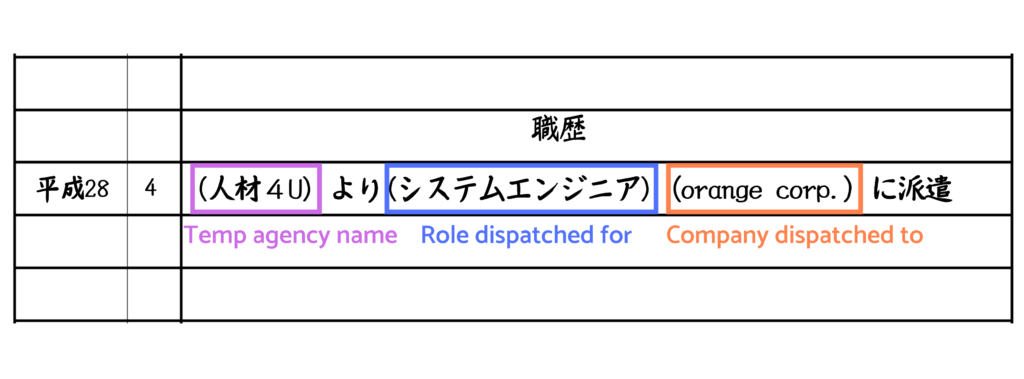
Gaps in employment
If you have any gaps in your employment history, be aware that, if you go through to an interview, some Japanese recruiters will ask about the reasons for these gaps.
If you had a gap because of illness, you don’t have to state this on your resume. Wait until it is brought up.
If the gap is for something that could be seen as beneficial to your application, or demonstrative of character, like a study abroad, you can take a line on the rirekisho to mention it if you wish.
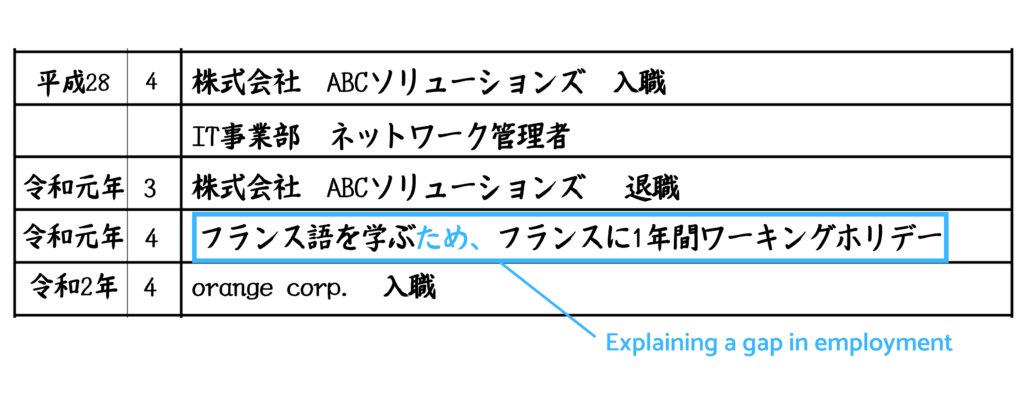
If you have any further questions about formatting a rirekisho, feel free to drop us a message via email, or on linkedin.
Next blog will look at the third part of the rirekisho, the Licenses and Qualifications section.




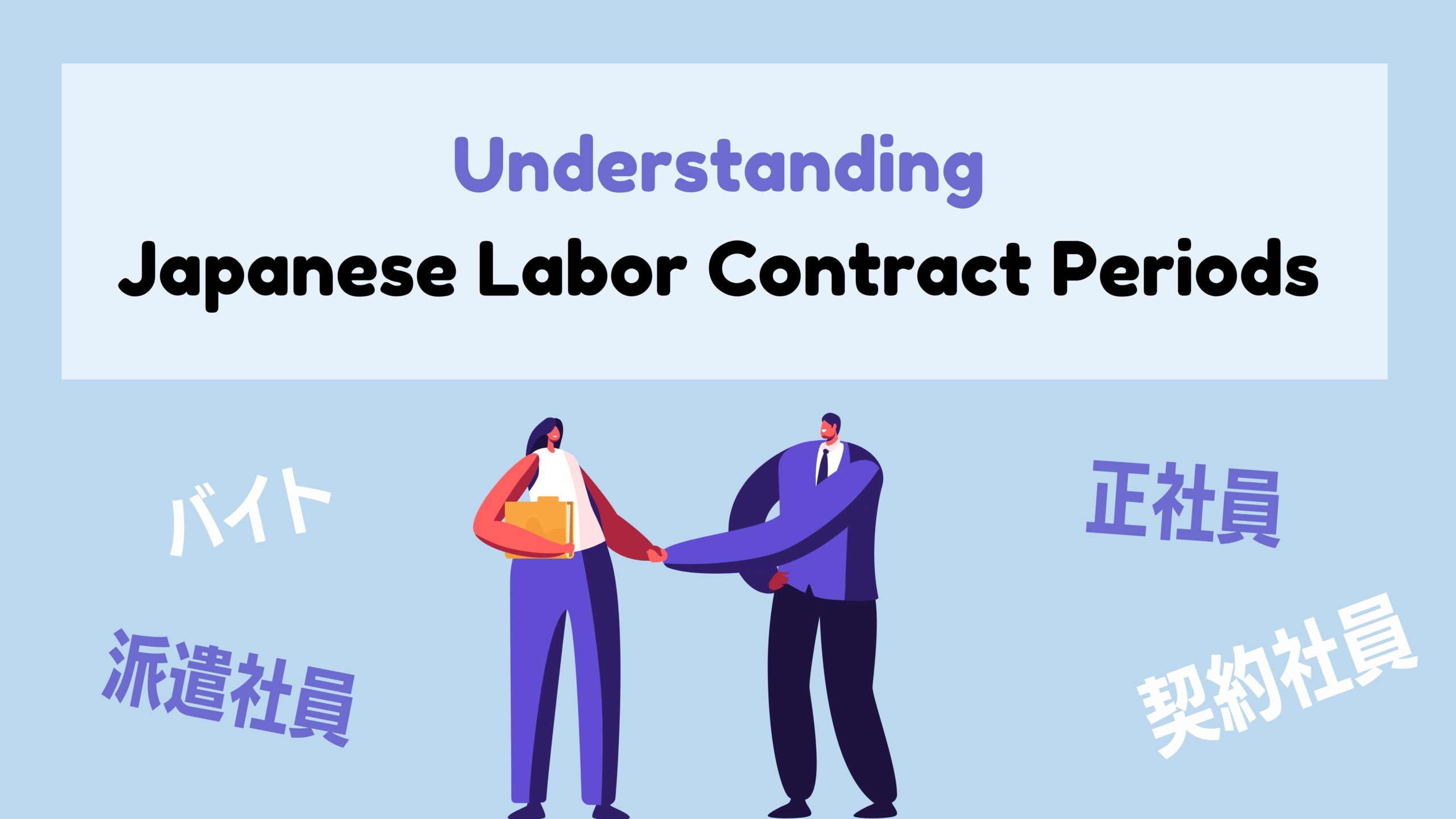



1 comment
Thanks for this fantastic explanation, not an easy job to write the rirekisho